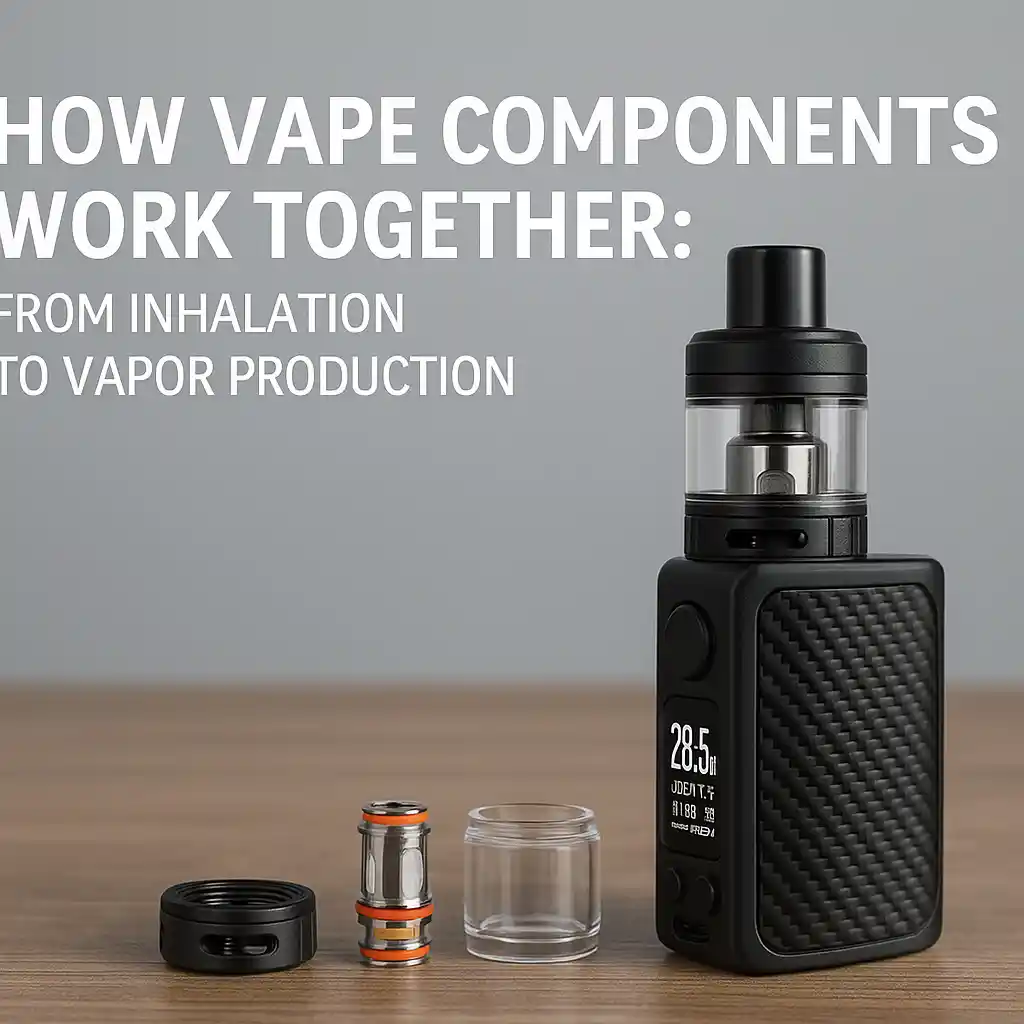Das kollaborative Arbeitsprinzip der wichtigsten Vape-Komponenten: Ein präziser Koordinationsprozess von der Inhalation bis zur Dampferzeugung
Wenn der Benutzer sanft einatmet, arbeiten sechs Hauptbestandteile des Inhalators zusammen. Das Gerät verfügt über spezielle Sensoren, Chips, Heizelemente und Flüssigkeitsspeichersysteme, die zusammenarbeiten, um sicherzustellen, dass der Benutzer sicher und reibungslos Dampf inhalieren kann. Dies ist das Ergebnis eines präzisen Hardware-Designs und intelligenter Software-Algorithmen, die der Schlüssel zur Optimierung der Benutzererfahrung sind.
Inhalations-Trigger: Das Instant Response System der Luftstromsensoren
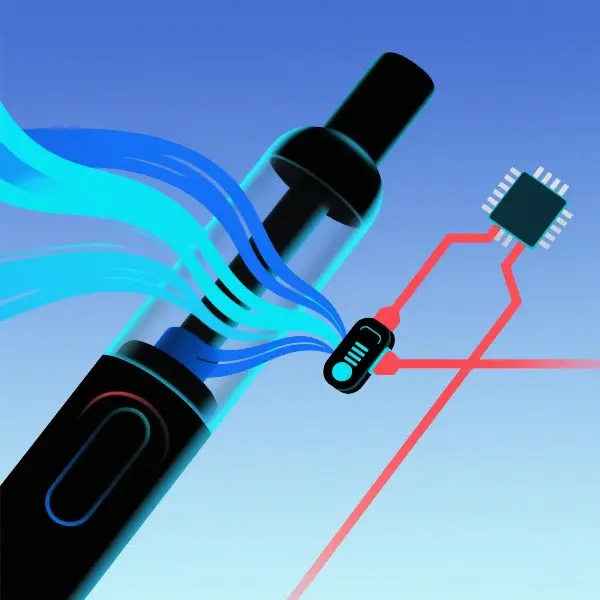
- Unterdruck-Sensorik: Der Luftstrom durch den Innendurchmesser des Drip Tips (Größe 510/810) erzeugt einen Druckunterschied. Der eingebaute MEMS-Sensor (Micro-Electro-Mechanical System) kann winzige Druckveränderungen mit einer Genauigkeit von ±0,05 kPa erkennen. Dadurch wird der Steuerchip in den Vapes aktiviert, der auf Druckveränderungen reagiert.
- Erkennung des Inhalationsmodus: Wenn Sie mit einem hohen Widerstand (mehr als 500 Pa) durch den Mund in die Lunge einatmen (MTL), gibt das Gerät eine geringe Leistung (10-20 W) ab. Wenn Sie mit einem geringen Widerstand (weniger als 200 Pa) direkt über die Lunge einatmen (DTL), gibt das Gerät eine starke Leistung ab (50-80 W). Dies bedeutet, dass Sie die Leistung leicht anpassen können, um Ihren bevorzugten Verdampfungsstil anzupassen.
- Anti-Missbrauch-Schutz: Das Gerät schaltet sich nach mehr als 8 Sekunden ununterbrochener Inhalation automatisch ab. Dies aktiviert eine spezielle Sicherheitsfunktion, die verhindert, dass die Spule von Überhitzung und Durchbrennen. Dies verhindert nicht nur trockene Verbrennungen der Spule, sondern verringert auch die Wahrscheinlichkeit, dass das Gerät bei neuen Benutzern um über 70% ausfällt.
Heizungsaktivierung: Präzise Leistungsregelung über PWM-Technologie
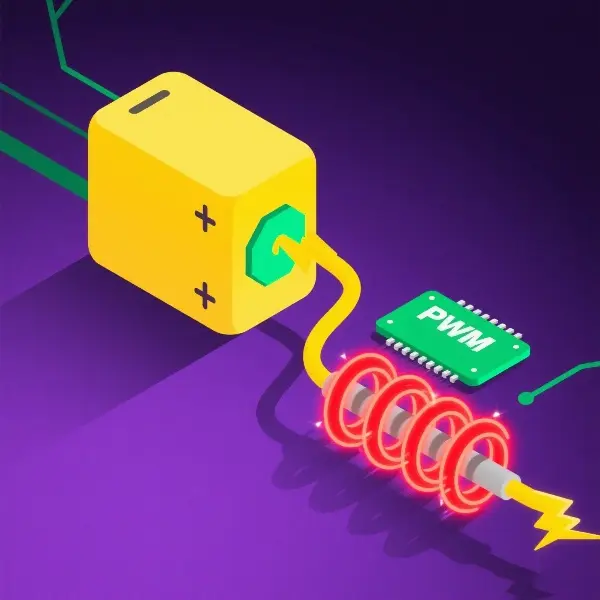
- Energiemanagement der Batterie: Eine Lithium-Batterie (3.7V/2500mAh) sendet Strom durch vergoldete Elektroden. Der Mod-Chip verwendet Pulsweitenmodulation (PWM) bei 100 kHz, um den Strom schnell ein- und auszuschalten, wobei das Verhältnis der Leitungszeit angepasst wird, um die Leistungsabgabe innerhalb von ±0,5 W durch Vape-PWM-Technologie für eine präzise Erwärmung zu steuern.
- Optimierungsalgorithmus für das Vorheizen: Wenn eine neue Spule erkannt wird, verwendet der Chip das 1,2-fache der normalen Leistung, um die Temperatur des Heizdrahts schnell auf den Zielwert zu erhöhen (Fehlerbereich: ±2 °C). Dadurch wird das Problem der uneinheitlichen Temperatur des ersten Puffs gelöst, indem sichergestellt wird, dass der erste Puff immer die gleiche Temperatur hat.
- Mechanismus zur Spannungsstabilität: Wenn die Batterie schwach wird, erhöht das System automatisch das Leitungsverhältnis (von 70% auf 85%), um sicherzustellen, dass die Leistung konstant bleibt. Dies wird als "Low-Battery Power Stability Technology" bezeichnet.
Zerstäubungsprozess: Das Mikro-Engineering von Wicking und Verdampfung

- E-Liquid Delivery System: Die E-Flüssigkeit (bestehend aus 60% pflanzlichem Glycerin und 40% Propylenglykol) im Tank sickert durch winzige Löcher in den Keramikfaserdocht der Wicklung und wird in nur 3 Sekunden vollständig durchtränkt (was schneller ist als die üblichen 5 Sekunden). Dies hilft, das Risiko des trockenen Brennens beim Dampfen zu stoppen, indem das Dochtsystem besser wird.
- Effiziente Verdampfung mit Mesh Coils: Edelstahl-Mesh-Coil-Technologie verdampft 0,15 ml e-Flüssigkeit pro Sekunde bei 180 ° C, produziert 3 mal mehr Mikron-Level-Dampfpartikel (2-5μm) als herkömmliche Spulen. Dies macht das Dampfvolumen und Geschmacksreinheit besser durch große Dampfproduktion und Geschmacksreinheit.
- Regulierung der Atemwegstemperatur: Dampf wird kalt genug gemacht, um leicht eingeatmet werden (um 42℃) durch eine 45mm Spirale Kanal, der die Menge an Kondensat in der Luft von über 90% dank einer speziellen Technologie reduziert.
Dynamische Anpassung: Echtzeit-Temperaturmanagement über PID-Algorithmus
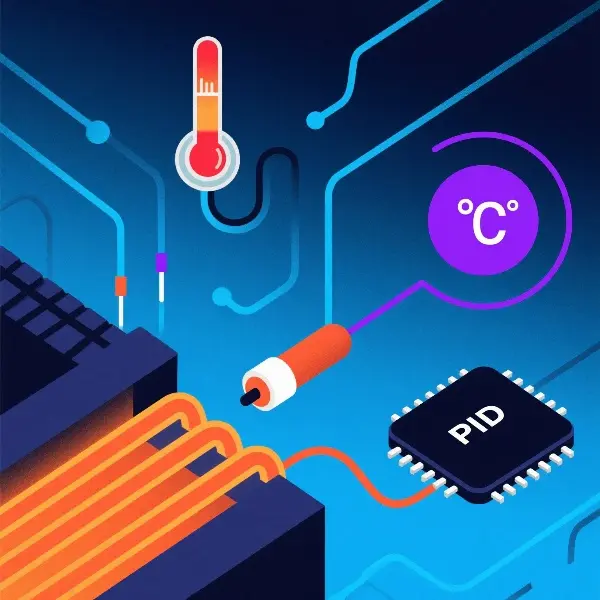
- Widerstandsüberwachung: Der Mod kann den Spulenwiderstand 100 Mal pro Sekunde messen (±0,005Ω). Wenn der Widerstand wegen schlechter Dochtwirkung steigt (z.B. 0,5Ω→0,7Ω), reduziert der PID-Algorithmus (proportional-integral-derivative) die Ausgangsleistung um 15%, um die Zieltemperatur (220℃±5℃) zu halten, und macht die Spule letzten 20% länger, dank der PID-Algorithmus für die Spule Lebensdauerverlängerung.
- Kompatibilität mit mehreren Materialien: Das System unterstützt Materialien für die Temperaturkontrolle, wie Nickel (Ni200), Titan (Ti) und Edelstahl (SS316). Der Benutzer kann die Temperaturgrenzwerte (100-300 °C) je nach Spulenmaterial einstellen, so dass das System sowohl für Mund-zu-Lunge- als auch für Direkt-zu-Lunge-Hochtemperaturanwendungen geeignet ist.
- Lernen der Nutzungsgewohnheiten: Die High-End-Mods können Daten für die fünf am häufigsten verwendeten Coils speichern. Sie tun dies durch die Coil-Daten-Speicherfunktion. Diese Funktion passt automatisch die optimalen Leistungskurven für jede Spule an. Dies stellt sicher, dass jede Spule bekommt eine vaping Erfahrung, die genau das Richtige für sie ist.
Sicherheit Schutz: Ein 24/7-Sicherheitsnetz mit siebenfachem Schutz
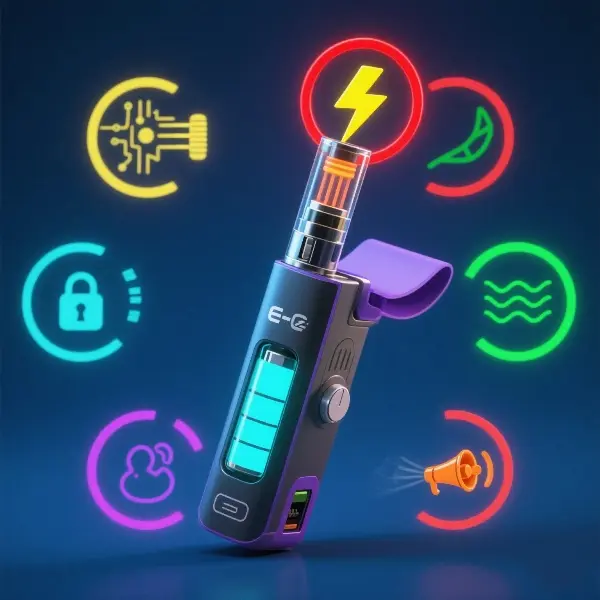
Die Sicherheitsmechanismen des Vapes wirken wie sieben unsichtbare Wächter, die in allen Situationen für Sicherheit sorgen:
- Überhitzungsschutz: Wenn die Spulentemperatur über 300°C oder die Batterietemperatur über 60°C steigt, überprüfen sich zwei NTC-Sensoren gegenseitig und unterbrechen die Stromversorgung für 15 Millisekunden. Dies geschieht mit einem Vibrationsalarm, der durch den Überhitzungsschutz Schäden an Komponenten oder Gefahren durch hohe Hitze verhindert.
- Kurzschlussschutz: Wenn der Stromkreiswiderstand unter 0,1Ω fällt oder der Strom 15A überschreitet, werden die Sicherung und die Softwaresperre innerhalb von 8ms aktiviert. Dadurch wird verhindert, dass die Batterie im Falle eines Kurzschlusses Feuer fängt.
- Schutz vor Unterspannung: Wenn Sie das Gerät innerhalb von 20 Millisekunden ausschalten und die Impuls-Weckerkennung aktivieren, wenn die Batteriespannung unter 3,0 Volt fällt, werden irreversible Schäden durch Tiefentladung durch den Unterspannungsschutz vermieden.
- Überladungsschutz: Wenn die Spannung des Akkus mehr als 4,25 V beträgt, während er aufgeladen wird, werden die beiden Abschaltmechanismen (Ladegerät und Mod) innerhalb von 1 ms aktiviert. Dies verhindert, dass der Akku anschwillt oder wegen Überladung explodiert.
- Kindersicherung: Durch fünfmaliges Drücken der Feuertaste innerhalb von fünf Sekunden wird der Sperrmodus ausgelöst. Um die Sperre aufzuheben, müssen Sie die Feuertaste und die Einstelltaste gedrückt halten. Dies verhindert, dass Kinder oder Haustiere die Sperre versehentlich aktivieren (z. B., WASPE 25000 25K Puffs Einweg Vape).
- Verhinderung von Kippleckagen: Der Tank hat einen eingebauten Schwerkraftsensor. Das heißt, wenn Sie den Tank zwei Sekunden lang um mehr als 60° kippen, schließt sich der Flüssigkeitsauslass innerhalb von 100 Millisekunden. Dadurch wird ein Auslaufen beim Tragen des Tanks verhindert.
- Kondensationsalarm: Wenn die Luft zu feucht ist (über 85% RH), vibriert das Gerät und die Leistung wird innerhalb von 50 Millisekunden um 10% reduziert. Dies erinnert den Benutzer daran, die Tropfspitze und die Atemwege zu reinigen, um Husten oder Schäden an der Spule durch Kondensation zu vermeiden.
Gemeinsamer Wert: Vom Stapeln von Komponenten zum Erfahrungs-Upgrade
Vapes sind wettbewerbsfähig, weil sie Akkuleistung, Chipintelligenz, Zerstäubungseffizienz und Sicherheitsschutz in einem funktionierenden System vereinen. Jedes Mal, wenn Sie inhalieren, arbeiten die Hardware und die Software perfekt zusammen. Für die Nutzer bietet diese reibungslose Zusammenarbeit drei wesentliche Vorteile:
- Vapes haben sieben Schichten von Sicherheitsschutz. Dies reduziert das Risiko von Kurzschlüssen und Überhitzung durch über 98%.
- Stabile Erfahrung: PID-Temperaturregelung hält die Dampftemperatur und Konzentration Fehler unter 3%.
- Persönliche Anpassung: Sie können es anpassen, wie Sie wollen, von der Inhalation Stil auf die Spule Material und andere Einstellungen vaping, so ist es perfekt für neue Benutzer und erfahrene vapers.
Das Verständnis dieser Zusammenhänge hilft den Nutzern, mit Hilfe eines Leitfadens für die Auswahl von Vape-Geräten die richtige Wahl zu treffen und durch die richtige Verwendung (z. B. regelmäßige Reinigung des Dochts, Vermeidung von Überladung) die Leistung optimal zu nutzen. Das Beste an Vapes ist, dass sie das Inhalieren leicht machen.
Jetzt, da wir wissen, wie die Kernkomponenten harmonisch zusammenarbeiten, wollen wir uns die verschiedenen Verdampferarten ansehen, die auf diesen Prinzipien basieren. Als Erstes: Einwegverdampfer, die für ultimativen Komfort entwickelt wurden, aber auch Kompromisse eingehen. Wir werden ihre Benutzerfreundlichkeit gegen Umweltaspekte abwägen, um Ihnen bei der Entscheidung zu helfen, ob sie Ihren Bedürfnissen entsprechen. Ähnlicher Artikel: "Was ist ein Einweg-Vape?“.
